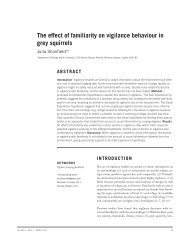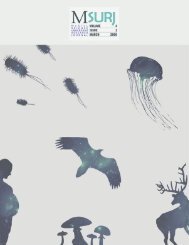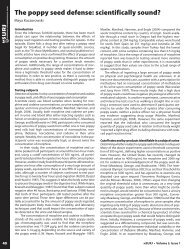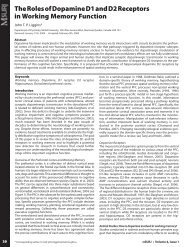the entire issue - McGill Science Undergraduate Research Journal ...
the entire issue - McGill Science Undergraduate Research Journal ...
the entire issue - McGill Science Undergraduate Research Journal ...
You also want an ePaper? Increase the reach of your titles
YUMPU automatically turns print PDFs into web optimized ePapers that Google loves.
Stress reactivity during evaluation by <strong>the</strong> opposite sex: comparison of responses induced by different psychosocial stress tests<br />
version of <strong>the</strong> CPT that included a social evaluative component: <strong>the</strong><br />
Socially Evaluated Cold Pressor Task (SECPT) (18). This test induces<br />
higher levels of salivary cortisol than <strong>the</strong> CPT alone, reinforcing <strong>the</strong><br />
idea that social evaluation significantly increases HPA axis activity.<br />
Most recently, Smeets et al. (2012) introduced <strong>the</strong> Maastricht Acute<br />
Stress Test (MAST) consisting of fixed SECPT intervals (CPT with social<br />
evaluation) separated by mental arithmetic challenge periods.<br />
The authors compared <strong>the</strong> responses achieved with <strong>the</strong> MAST with<br />
those from o<strong>the</strong>r stress paradigms, in this case CPT and SECPT, or<br />
TSST. They concluded that subjects’ cortisol levels after MAST appeared<br />
higher than in both CPT and SECPT. A comparison of <strong>the</strong> MAST<br />
and TSST suggested that cortisol response curves were comparable<br />
in magnitude, and followed a similar progression (19). Carrying out<br />
all four tests within <strong>the</strong> framework of <strong>the</strong> same study allowed variables<br />
such as collection techniques, exclusions, protocol, and group<br />
size to be controlled. These results <strong>the</strong>refore suggest that <strong>the</strong> MAST<br />
may be a valid alternative to <strong>the</strong> TSST. The effectiveness of <strong>the</strong> MAST<br />
may be result of <strong>the</strong> fact that its CPT component provides a physical<br />
stressor that predominantly activates <strong>the</strong> SAM axis (indicated by<br />
elevated heart rate and blood pressure), while <strong>the</strong> social evaluation<br />
and mental arithmetic components of <strong>the</strong> TSST activate <strong>the</strong> HPA axis<br />
(indicated by higher levels of salivary free cortisol) (19).<br />
The effect of subjects’ sex is ano<strong>the</strong>r potentially significant factor. Numerous<br />
studies have shown that <strong>the</strong> two groups who display greatest<br />
cortisol responses to a standard TSST are women in <strong>the</strong> luteal phase<br />
of <strong>the</strong>ir menstrual cycle, and men (10). However, a recent study by<br />
Duchesne et al. (2011) has shown that women in <strong>the</strong> follicular phase of<br />
<strong>the</strong>ir menstrual cycle and men show higher cortisol levels compared<br />
to women in <strong>the</strong> luteal phase and controls when <strong>the</strong> social evaluation<br />
during <strong>the</strong> TSST was carried out by an experimenter of <strong>the</strong> opposite<br />
sex (4). This is possibly a result of <strong>the</strong> fact that women in <strong>the</strong> follicular<br />
phase of <strong>the</strong>ir menstrual cycle display increased responsiveness<br />
and physiological arousal towards men and masculine stimuli (e.g.<br />
facial and vocal cues of men with high testosterone levels) (4, 6, 17).<br />
However, it is unclear whe<strong>the</strong>r any such gender differences exist in<br />
<strong>the</strong> MAST. The work by Smeets et al. (2012), introducing <strong>the</strong> MAST,<br />
tested it on twenty men and no women. The results were subsequently<br />
compared to men-only TSST and CPT versions. As of yet, no project<br />
has directly compared all three stress tests at one time while including<br />
women. Such a study would be able to determine whe<strong>the</strong>r <strong>the</strong><br />
MAST affects women in <strong>the</strong> follicular phase of <strong>the</strong> menstrual cycle<br />
differently from men when <strong>the</strong>y are evaluated by experimenters of<br />
<strong>the</strong> opposite sex.<br />
We hypo<strong>the</strong>sized that <strong>the</strong> results of <strong>the</strong> current project would demonstrate<br />
that <strong>the</strong> administration of a psychosocial stress test by an<br />
experimenter of <strong>the</strong> opposite sex would lead to a comparable stress<br />
response in women in <strong>the</strong> follicular phase of <strong>the</strong>ir menstrual cycle<br />
and men. Fur<strong>the</strong>r, we hypo<strong>the</strong>sized that <strong>the</strong> magnitude of <strong>the</strong> stress<br />
response would differ between different psychosocial stress tests<br />
(TSST, CPT and MAST), in that <strong>the</strong> MAST and <strong>the</strong> TSST would induce a<br />
greater cortisol (HPA axis) and autonomic (SAM axis) stress response<br />
than <strong>the</strong> CPT.<br />
Materials & Methods<br />
Subjects<br />
For <strong>the</strong> MAST, we recruited 9 men (ages = 20-27 years, mean = 23.33<br />
years, sd = 2.45 years) and 8 women (ages = 18-21 years, mean = 19.50<br />
years, sd = 1.20 years) via advertisements posted in a variety of Montréal<br />
electronic classifieds. Interested individuals filled out a screening<br />
questionnaire, and we contacted those eligible for <strong>the</strong> study in<br />
order to conduct a follow-up interview. In order to avoid any influence<br />
of hormonal changes associated with age (such as puberty and<br />
menopause) <strong>the</strong> participants recruited were all between 18 and 35<br />
years of age. We excluded applicants who smoked more than 7 cigarettes<br />
a day, had a past history of psychiatric illness, had a body mass<br />
index (BMI, in kg/m 2 ) outside <strong>the</strong> range of 18-27, or were currently<br />
using steroid hormone medications and/or recreational drugs, as<br />
<strong>the</strong>se criteria have been known to affect baseline hormone levels (4,<br />
10). We scheduled female applicants who reported not using any oral<br />
contraceptives to undergo <strong>the</strong> MAST when <strong>the</strong>y were in <strong>the</strong> follicular<br />
phase of <strong>the</strong>ir menstrual cycle (by testing <strong>the</strong>m 2-13 days following<br />
<strong>the</strong> onset of menstruation; assessed via self-report and monitoring<br />
through phone calls). Women reporting <strong>the</strong>mselves as pregnant were<br />
not allowed to participate. The Douglas <strong>Research</strong> Ethics Board approved<br />
this project<br />
For <strong>the</strong> TSST, we included a total of 23 subjects (n men<br />
= 12, n women<br />
= 11;<br />
age mean = 23.09 years), and for <strong>the</strong> CPT, a total of 17 subjects (n men<br />
= 11, n women<br />
= 6, age mean = 23.35). Although different experimenters<br />
carried out each test, laboratory standards in all stress tests ensured<br />
that <strong>the</strong> same exclusion criteria were used, that participants were<br />
within <strong>the</strong> same age brackets and chosen from <strong>the</strong> same (predominantly<br />
undergraduate) student population, and that <strong>the</strong> same cortisol<br />
analysis methods and measurement instruments were used. Fur<strong>the</strong>rmore,<br />
only participants tested by an opposite-sex experimenter<br />
were included in our analysis so as to match our MAST sample. Only<br />
opposite-sex testing was employed due to time and resource constraints<br />
on carrying both same-sex and opposite-sex testing. Across<br />
all stress tests, <strong>the</strong> only outstanding difference that emerged during<br />
our analysis was that <strong>the</strong> CPT study involved “high” and “low”<br />
self-esteem groups (as measured by <strong>the</strong> Rosenberg Self-Esteem Scale<br />
(RSES)). Therefore, analyses were run with CPT divided into CPThigh<br />
and CPT-low groups.<br />
General Procedure<br />
Testing took place at <strong>the</strong> Douglas <strong>Research</strong> Institute between 1 and 5<br />
12<br />
<strong>McGill</strong> <strong>Science</strong> <strong>Undergraduate</strong> <strong>Research</strong> <strong>Journal</strong> - msurj.mcgill.ca









